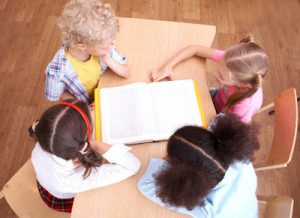Approximately 80 percent of all learning comes through the visual pathways.
Any interference in the visual pathways can inhibit a child from performing to his maximum potential.
According to the American Optometric Association (AOA), 25 percent of all children, or 1 in 4 students, have a vision problem significant enough to impact their learning.
A child may pass a visual acuity eye exam and still have an undetected vision problem— mainly because 20/20 eyesight does not indicate “perfect” functioning of the visual skills. In other words, visual problems do not only stem from blurry vision, but can be caused by reduced visual skills as well.
Schedule an eye exam with an eye doctor near you who has experience diagnosing and managing vision problems.
SEE RELATED: The Power of Visualization
How can vision problems impact learning?
Strong visual skills are essential for all aspects of learning.
Vision problems do not go away on their own and will persist into adulthood if not treated. In many cases, adults are not even aware that their difficulties are caused by a vision problem— leading to years of avoidance of difficult activities.
Therefore, it is essential to obtain an accurate diagnosis of a vision problem, and appropriate treatment as early as possible.
Vision problems can impact:
- Reading
- Spelling
- Handwriting
- Reading comprehension
- Homework completion
- Classroom performance
- Concentration and attention
- Visual arts
If your child’s vision is affecting any of these areas contact an eye doctor near you.
Visual skills are essential for learning
This page is a guide to facilitate understanding of the visual skills, and how they are needed for each of the fundamental components of learning. Visual skills can be improved with a personalized program of vision therapy.
Reading
Why is reading important?
Not only is reading fun, but reading can help build a child’s language skills which further helps to develop vocabulary. Additionally, the ability to read is essential for communication, and truly opens up the world to a child. Reading books teaches children about the past, present, and future— different cultures, histories, and societies. It allows a child to use their imagination, and is a great tool for relaxation!
Visual skills necessary for reading:
- Saccades and Visual integration
Saccades is a skill that allows you to read sentences in a fluid manner, with the two eyes moving smoothly across the line, in coordination.
Without saccades, a child may omit words in a sentence, or make assumptions, filling in words that may not actually appear on the page.
Visual integration is a skill that allows you to read words correctly— seeing the shapes and order of the letters accurately.
Without visual integration, a child may confuse letters that are similar in shape, such as b and d, or p and q; or confuse words such as ‘saw’ and ‘was’. Additionally, without laterality — a skill that falls under visual integration, a child will struggle with reading from left to right, or from the top of the page to the bottom.
Spelling
Why is spelling important?
Spelling is important because it facilitates reading ability — cementing the connection between sounds and letters, and enabling language proficiency. In addition, proper spelling facilitates written communication— poor spelling distracts the reader because it is difficult to read a text when it’s full of spelling errors.
Visual skills necessary for spelling:
- Pursuits and Focusing
Pursuits allow you to read a word, one letter at a time, with slow, smooth binocular movements. Pursuits enable your eyes to scan across a word in order to read it accurately, sounding out each letter in the word.
Without this visual skill, a child may omit sounds, reading the word ‘through’ as ‘though’— or may assume that the ‘r’ is there, pronouncing the word correctly, even though it was not seen. These omissions and assumptions often lead to spelling mistakes.
Focusing skills allow you to see a word clearly and comfortably. Just as a camera needs to be in focus to capture a clear picture of an image, the same is true with your eyes when it comes to seeing a word with absolute clarity.
Without this visual skill the child will experience difficulties seeing words clearly and comfortably
Handwriting
Why is handwriting important?
Legible handwriting is still an essential educational requirement for optimal performance on exams and assignments. Legible handwriting is also important for taking notes by hand, which is crucial for students of all ages because it facilitates improved attention and comprehension.
Legible handwriting can have a positive impact on grades, while illegible handwriting can lead to difficulties in proofreading and detecting mistakes. Moreover, illegible handwriting can result in poor self expression, or avoidance of writing tasks altogether.
Visual skills necessary for handwriting:
- Fine visual motor and Visual perception
Fine visual motor skills allows you to write appropriately sized letters, in a neat fashion. Reduced fine visual motor skills can cause a child to press too hard onto the page when writing, which can lead to muscle fatigue, or strain injuries to the muscles in the hand and wrist.
Visual perception allows you to process visual information such as the shape and sound of a letter, or a complete word. This cognitive process is required to trigger a subconscious motor response, by initially seeing the word in your head then actually writing the letters and words.
A combination of these skills ensures that the sequence of letters are written within the lines, correctly oriented, consistently sized, and appropriately spaced.
Reading comprehension
Why is reading comprehension important?
Reading comprehension is essential for understanding, processing, and recalling what was read. Reading comprehension difficulties will impact a child’s ability to answer questions based on text. Additionally, a child may become frustrated as a result of not fully understanding what is being read— many times, resulting in avoidance of reading altogether.
Visual skills necessary for reading comprehension:
- Visual Memory and Convergence
Visual memory allows you to visualize, or imagine, the scene of a book in your mind. Visualization enables increased comprehension of text, and consequently enhances your ability to recall what was read.
Convergence allows you to focus both of your eyes inward, in order to see an image clearly. Convergence is an essential skill for reading, as well as looking at a computer screen comfortably, for an extended period of time.
Convergence Insufficiency is one of the most common visual problems experienced by up to 15% of all children.
Homework
Why is homework important?
There is a positive correlation between homework completion and academic achievement. Homework completion encourages children to work independently, and enables a deeper understanding of subjects. Homework is also essential in improving memory and critical thinking, and increases test grades.
Visual skills necessary for homework:
- Accommodation endurance and Binocular coordination
Accommodation endurance allows you to maintain focus for reading and other close vision tasks, for an extended period of time. Many children can focus clearly at the beginning of the day, but after a few hours, fatigue sets in—making it difficult for them to focus on their homework assignments.
Binocular coordination allows you to use both eyes at the same time, in coordination, for clear and comfortable vision. Poor binocular vision can result in fatigue and avoidance of homework. In some cases poor binocular vision can result in blurry or even double vision.
Concentration and attention
Why are concentration and attention important?
Children who are able to concentrate and pay attention during class become successful students. If a child is unable to concentrate during class, his academic performance will be affected significantly.
Concentration is necessary for following instructions, completing assignments and exams, and understanding the material being taught.
Visual skills necessary for concentration and attention:
- Peripheral vision and Gross visual motor control
Peripheral vision allows you to see what is going on around you, without having to turn your head. This skill enables a child to attend to a task without being easily distracted by noises or movement in their environment.
Gross visual motor allows you to sit at a desk, with correct upright posture— enabling increased attention to school work and the teacher’s lesson. A child with reduced gross visual motor skills will typically display poor posture while sitting behind a desk, resulting in an inability to concentrate properly.
Classroom vision
Why is classroom vision important?
Classroom vision is needed for seeing what is written on the whiteboard, taking notes off the whiteboard, following directions, and more!
Visual skills necessary for optimal classroom performance:
- Central vision acuity and Accommodation flexibility
Central vision acuity allows you to see distant images with clarity. This skill is needed in the classroom for many different reasons, one of them being the ability to clearly see what is written on the whiteboard.
Accommodation flexibility allows you to switch focus from near to distant images. This skill is necessary for taking notes from the whiteboard— looking from the whiteboard to your book, and then back to the whiteboard, continually.
Visual arts
Why are visual arts important?
Participating in visual art activities facilitates physical, emotional, cognitive, and social development. Visual arts help to build a child’s imagination, as they invent new ways to create art. Moreover, visual arts strengthen a child’s decision making and problem solving skills — color, size, and placement are important factors in the creation of artwork.
Visual skills necessary for visual arts:
- Visual thinking and Color perception
Visual thinking or processing allows you to analyze and form a mental image in your mind. Visual thinking is essential for painting, drawing, and all forms of visual arts —as it enables a child to visualize the artwork they plan to create, before beginning the project.
Color perception allows you to distinguish between different colors. This skill is necessary for appreciating the detail, depth and complexity of what is seen.
Treatment of vision problems
Strong visual skills are essential for academic success.
All of the fundamental components of learning rely heavily on the strength of the visual skills. It is important to treat vision problems as early as possible in order to enable a child to reach their full potential— and to facilitate optimal outcomes.
If your child is struggling academically, take this quiz to find out if they may be suffering from a vision problem, and be sure to schedule a comprehensive vision evaluation.
LEARN MORE: Vision Therapy for Children
Schedule an appointment with a vision therapy eye doctor. They will be able to detect the presence of a vision problem, and discuss the benefits of vision therapy— an effective treatment method for the improvement of visual skills.
Your child’s visual skills are essential for their optimal learning performance, and overall academic success.










